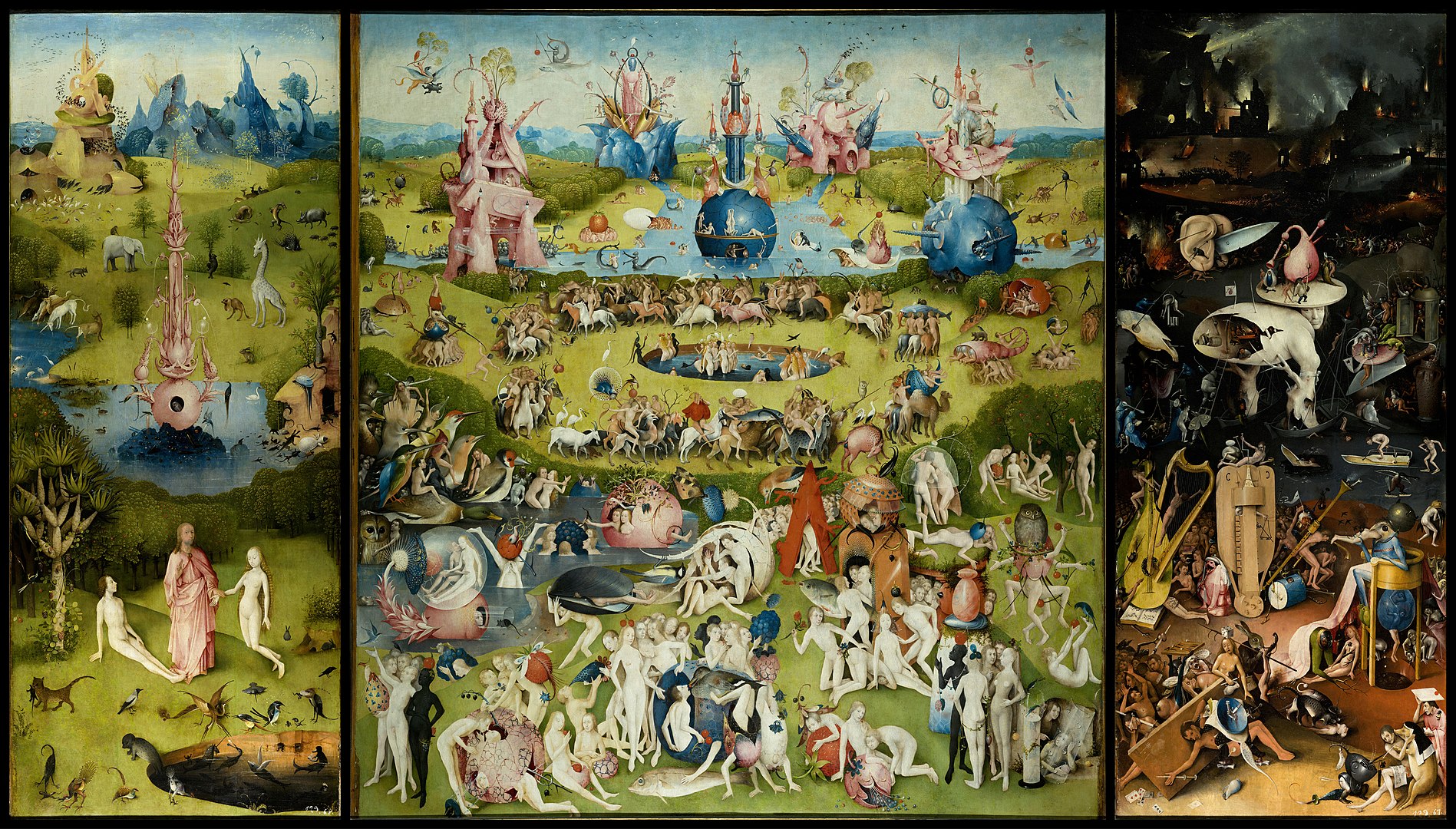
A Mysterious Masterpiece that Dares to Question the Human Soul
In the softly lit halls of Madrid’s Museo del Prado, one painting draws pilgrims of art and curiosity like moths to a surreal, impossible flame. Encased in protective glass, The Garden of Earthly Delights by Hieronymus Bosch looms large, not merely in size, but in its spiritual weight. This late 15th-century triptych is more than just oil on oak; it’s a fever dream carved into paint, a world that dances between ecstasy and damnation. Viewers stand before it, awe-struck and often baffled, gazing at the chaotic scenes that swirl across the panels, angels and alchemists, giant birds, naked lovers, half-human beasts, and apocalyptic horrors.
But what does it all mean? Why has this strange, sensual, and sometimes grotesque painting stirred such controversy? Why is it in Spain, and not in Bosch’s homeland, the Netherlands? What is it about this particular artwork that, five centuries later, still casts a spell?
Let’s step into the garden together and explore.
A Glimpse Behind the Curtain: What is The Garden of Earthly Delights?
Painted sometime between 1490 and 1510 by Dutch master Hieronymus Bosch, The Garden of Earthly Delights is a triptych, three panels hinged together. Closed, it reveals a monochromatic image of Earth during Creation, a misty, otherworldly globe under God’s watchful gaze. But once opened, it explodes into color and chaos.
Left Panel: A vision of Eden. Here, God introduces Adam and Eve beneath fantastical pink structures. Exotic animals roam the strange, dreamlike landscape. All is in balance, for now.
Center Panel: A sprawling panorama of earthly delights, where humans engage in hedonistic revelry. Naked figures tumble through oversized fruits, birds feed lovers, and bodies intertwine in a world seemingly unbound by sin or shame. It’s a playground, but one that feels slightly… off. The pleasure here is overwhelming, and perhaps, too perfect.
Right Panel: A dark, horrifying vision of Hell. Twisted creatures torment sinners in inventive, even ironic ways, musicians punished by the very instruments they once played, gluttons force-fed grotesque foods, and a haunting “Tree-Man” whose hollow body shelters damned souls. This is the price, it seems, of indulgence.
Each panel is a world unto itself. Together, they tell a story that many have tried, and failed, to fully decode.
Why Was The Garden of Earthly Delights Controversial?
When Bosch painted this masterpiece, the world was steeped in religious orthodoxy. The Catholic Church was the undisputed authority, and art served as a means to glorify God and instruct the faithful. So imagine the shock: a painting filled with nudity, surreal creatures, and scenes of sensual delight. It defied conventional morality and offered no clear didactic message.
Some early critics saw Bosch as a madman, or worse, a heretic. This wasn’t the gentle moralism of medieval religious art. This was bold, chaotic, and ambiguous.
The painting’s center panel, in particular, sparked controversy. Was Bosch celebrating earthly pleasure? Or was he condemning it? The answer seemed to twist and change depending on who was looking. Even more daring was the use of satire and symbolism that mocked human folly, a dangerous game when the Church’s wrath was just a whisper away.
And yet, despite its risks, the painting survived. Perhaps it was protected by its ambiguity, or by powerful patrons who saw in Bosch’s strange visions not blasphemy, but brilliance.
The Meaning Behind the Madness
So, what is The Garden of Earthly Delights really about?
Art historians still argue. Some believe Bosch intended it as a moral warning against the temptations of the flesh. Others think it was a private commission meant for intellectual contemplation rather than public preaching. One theory suggests the center panel shows what the world might have looked like if humanity had never fallen, an innocent Eden of pure pleasure, now lost.
The lack of clear explanation is exactly what makes the painting so enduring. Bosch leaves space for the viewer to bring their own meaning. That, in a way, is its genius.
Yet certain themes do rise to the surface:
Temptation and Consequence: The triptych moves from innocence (left) to indulgence (center), and finally, to damnation (right). It’s a visual sermon about how pleasure, unchecked, leads to ruin.
Human Folly: Many figures are engaged in absurd acts, riding giant fish, crawling into eggshells, or caressing enormous fruits. These aren’t just surreal images; they’re metaphors for vanity, lust, and self-destruction.
Nature’s Role: The natural world is both beautiful and strange in Bosch’s hands. Fruits, animals, and plants dominate the canvas, suggesting that creation itself may be complicit in mankind’s fall. Or perhaps, nature reflects the surreal inner world of human desire.
The Painting’s Message: A Mirror of the Soul
More than a warning or a riddle, The Garden of Earthly Delights is a mirror. It reflects the complexity of the human soul, its longing for pleasure, its tendency toward folly, and its inevitable reckoning. It challenges the viewer to consider: where am I in this triptych?
Are you walking in Eden? Cavorting in earthly pleasure? Or suffering the torment of self-inflicted damnation?
Bosch doesn’t preach. He doesn’t offer salvation. Instead, he invites us to witness ourselves, our beauty, our absurdity, our tragedy.
This, perhaps, is the most subversive thing of all.
The Theme: A Timeless Allegory
Though painted over 500 years ago, the themes of The Garden of Earthly Delights remain hauntingly relevant. At its heart, the work grapples with:
Desire vs. Discipline
Freedom vs. Consequence
Innocence vs. Corruption
The Spiritual vs. the Carnal
The painting is not just about religion; it’s about being human. It’s about the eternal tension between our highest ideals and our basest instincts.
Modern viewers, standing in the climate-controlled quiet of the Prado, feel these themes acutely. In an age of excess, distraction, and information overload, Bosch’s surreal warnings ring eerily true.
Where is The Garden of Earthly Delights Displayed?
Today, the painting resides in the Museo del Prado in Madrid, Spain. It is one of the most visited pieces in the museum and often considered one of the greatest paintings in Western art history.
Its placement in the Prado is part of what gives it such a mythic aura, surrounded by Velázquez, Goya, and El Greco, Bosch’s visions stand as something older, wilder, and wholly unique.
Why is The Garden of Earthly Delights in Spain?
Given that Bosch was Dutch, it’s natural to wonder why his most famous painting ended up in Spain.
The answer lies in royal taste. In the 16th century, the Spanish Habsburgs were avid collectors of Bosch’s work. King Philip II of Spain, deeply pious and fascinated by religious art, was particularly drawn to Bosch’s mystical themes and complex symbolism.
Philip had the painting brought to the Escorial, the royal monastery and palace just outside Madrid. He didn’t hang it in a gallery or dining hall, but in his private quarters, perhaps seeing in its themes a personal resonance. For decades it remained tucked away from the public, a secret mirror to power and piety.
Eventually, the painting was transferred to the Prado, where it could be studied and admired by the world. And so, by an accident of history and royal obsession, Bosch’s Dutch masterpiece became one of Spain’s national treasures.
A Garden for the Ages
The Garden of Earthly Delights is not a painting to be understood in a single viewing. It resists simplification. It is at once beautiful and grotesque, sacred and profane, playful and terrifying. It is the mind of Hieronymus Bosch laid bare, a map of humanity’s passions, fears, and possibilities.
To look upon it is to time-travel into a world both foreign and familiar. We recognize ourselves in the writhing bodies, the gluttonous feasts, the yearning for something beyond the mundane. And we shudder at the price such freedom may exact.
That’s the power of great art: not to give answers, but to provoke questions.
So if you ever find yourself in Madrid, don’t miss the chance to stand before The Garden of Earthly Delights. Take your time. Let your eyes wander. Notice the strange, the sublime, the sinister.
And ask yourself: What kind of garden are you tending in your own life?




